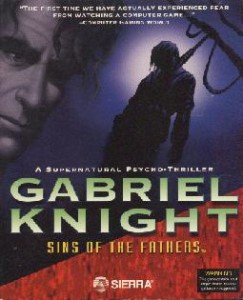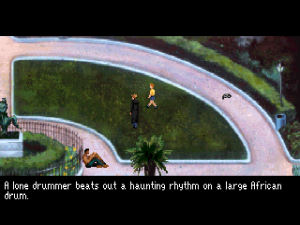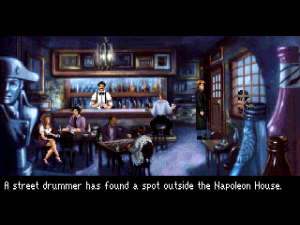This post isn’t about adventure games. It only reads that way.
For four decades, the adventure game genre has been practically synonymous with “story-driven” video games. In the early 1980s, Infocom was trading in thought-provoking, experimental text-only narratives while pioneering role-playing game series like Ultima and Wizardry were still fumbling with the basics. (We won’t even talk about contemporary narrative in other genres.) By the 1990s, non-adventure games had become more competitive in the storytelling sphere, but companies like Sierra and LucasArts were still where gamers went when they wanted “pure” interactive narrative that eschewed complex combat mechanics or action sequences.
Times have cha nged. The adventure game genre is still around, but is no longer a dominant industry force. Now even first-person shooters and other action games are marketed with a strong emphasis on story.
nged. The adventure game genre is still around, but is no longer a dominant industry force. Now even first-person shooters and other action games are marketed with a strong emphasis on story.
What hasn’t changed is the way story and gameplay are separated in most games. We continue to see games structured as a sequence of story moments broken up by gameplay challenges (or vice-versa), whether those challenges are comprised of elaborate combat systems, exploration and discovery, or object interaction puzzles. Sometimes the line between story and gameplay is perfectly blurred or the transition made seamless; more often, it’s stark.
In traditional media, conventional wisdom says that every element of a narrative piece (whether a line of dialogue or the color palette of a theater set) should advance a story’s plot, characters, or themes in some way. It’s a high aspiration and, I think, a worthy one. It’s something that games can aspire to, as well, in how they craft their challenge-based gameplay.
Another way to look at how well gameplay integrates into narrative is to ask, “If I were to adapt this game’s story to another medium, or recount the story to a friend, would I mention this challenge? Or would I skip over that part altogether?”
As a genre that, broadly speaking, aims to provide extremely high density story delivery, adventure games make for interesting examples in gameplay integration. That is, adventure games often pride themselves on eschewing extraneous, repetitive gameplay in favor of narratively integrated challenges; but even within adventure games, some challenges suit the narrative far better than others.
Let’s look at a few examples of traditional adventure game puzzles and see what we can learn:
The Longest Journey – Rubber Duck. The duck puzzle from The Longest Journey (Funcom, 1999) has been examined and excoriated more than once. It’s notable not only for its artificiality but because it’s a particularly bad fit in a game that makes a real effort at maintaining a consistent tone to the larger narrative.
I won’t break down the puzzle in detail (the preceding links do so thoroughly). Suffice it to say that The Longest Journey‘s protagonist sets out retrieve a key from an electrified subway track. Her motivation for acquiring the key is poorly established, at best–it unlocks a fuse box she wants access to (in order to create a diversion), though she has no way of knowing this–and her method involves building an elaborate contraption using, in part, a rubber duck.
But forget the overcomplicated solution to the puzzle–that’s absurd on its surface. More importantly for our purposes, what does retrieving the key have to do with the larger narrative? Does it advance character or theme? Would you choose to show it in your film or novel adaptation of the story?
Does it even make sense within the context of the game world? Are there simpler or more character-appropriate ways to accomplish the same goal? This is a less obvious trap than the sheer complexity of the puzzle–how many game protagonists go to elaborate lengths to move crates, murder foes, or retrieve that one special object when buying a ladder, making a phone call, or getting a replacement special object would be at least as simple?
Loom – Dyeing Sheep. Loom (Lucasfilm Games, 1990) fits into a subtradition of adventure games in which the primary game mechanic represents some flexible “power” on the part of the protagonist, and where creative use of this power is valued above object interaction puzzles (of the “use chewing gum on leaky pipe” variety). In Loom, the power is an array of magic spells the player character learns over the course of the game; I view Loom as a successor to games like Enchanter (Infocom, 1983) (another game of spellcasting) and predecessor to adventures like Life is Strange (Dontnod Entertainment, 2015) (in which the protagonist manipulates time itself to solve troubles).
By centering both narrative and gameplay on a single concept (spellcasting, time manipulation, etc.), producing gameplay challenges that feel narratively integrated becomes much more straightforward. But that’s no guarantee that every challenge will feel perfectly appropriate. One of Loom‘s more artificial puzzles involves a shepherd who keeps losing sheep in her flock to a hungry dragon. To solve the problem, the player must cast a dyeing spell–a spell earlier learned through, essentially, random examination of a cauldron of dye on a mage’s island–to turn the sheep green and thus camouflage them in the field.
It’s not a downright unnatural solution, and it has a certain fairy tale logic, but it lacks the straightforward feel of using magic to disguise oneself or using a simple “close” spell to seal a rift. Loom is not a game about an archetypal trickster using lateral thinking to solve problems in unconventional ways, and thus, for me, the sheep puzzle falls flat from a narrative perspective. Even with a narratively integrated set of mechanics, challenges using those mechanics still need to clear certain bars for optimal synthesis.
Gabriel Knight: Sins of the Fathers – The Drums. Recently remade in a “20th Anniversary Edition,” Gabriel Knight: Sins of the Fathers (Sierra On-Line, 1993) is a game better remembered for its engaging supernatural mystery storyline and strong characterization than for its puzzles. In truth, its puzzles are something of a mixed bag, combining some highly traditional pixel-hunting, “find and use this arbitrary object in an unusual way for unconvincing reasons”-style puzzles with other puzzles that are integrated into the narrative perfectly.
Gabriel Knight‘s drum “puzzle” is one of my favorites in adventure game history. The protagonist is effectively an amateur detective, trying to unravel the mystery behind a series of murders in New Orleans. From day one of the storyline, the player encounters (in the background) drummers playing on the streets. On day four, the player spots an informant talking to one drummer and learns from him that the drummers are part of an information network, sending messages via coded drumbeats. Research turns up the particulars of the code, and by day six, the player is able to decode the messages and infiltrate a gathering of the murderers’ cult.
But there’s more to it than this. The drum puzzle intersects with another puzzle involving the cult’s written messages–publicly displayed in plain sight like the drums, encoded as graffiti. As part of this sequence of events, the player must alter one of the written messages to manipulate the scheduled gathering. The need to send an additional drum message comes up yet again later on.
What makes the drum puzzle so effective from a narrative perspective? Let’s look at three things:
First, it resonates with and further develops the character of the protagonist. It involves our amateur detective unraveling a mystery that wouldn’t feel out of place on a television procedural, honing his skills and applying them in more advanced ways. The alteration of the coded message emphasizes the protagonist’s status as a manipulator–a liar and a scoundrel–even while putting those skills to benevolent use.
Second, the drum puzzle builds on elements introduced into the setting long before it becomes game-relevant (the drummers) and continues building on those same elements after the first stage of the puzzle is complete. The existence of written coded messages is a logical extension of the musical communications network. The drums aren’t simply a component of a puzzle, but a thread in the overall story.
Third, the puzzle contributes significantly to the mood of the game. The revelation that the murderous cult is operating in plain sight, watching and communicating with its agents in daylight is effectively creepy. The fact that the player has seen non-gameplay-relevant drummers before helps build a sense of oppressiveness and paranoia.
In other words, we have here a puzzle that advances character, story, and theme. A genuine rarity!
I want to stress that a failure to perfectly integrate gameplay challenges into narrative doesn’t make a game bad. But it’s a certainly a detriment to the narrative experience and should be evaluated as such.
We could take the same approach with quests in role-playing games–does a mission to gather gemstones in a dangerous ruin to open a magically sealed door really fit the overall narrative, advancing story, character, or theme in a meaningful way? What about the first combat encounter with skeletons in the wizard’s tower? What about the next twenty combat encounters? If you were adapting your game into a novel, would you leave these sequences in?
Even an action-adventure game or a story-driven first-person shooter can be broken down in this way, with each objective, level, or gameplay sequence justifying itself (or not) on the pure narrative level.
Is there a way to maintain the challenge and depth of gameplay content while still fully justifying it? Can every puzzle be a secret drum message puzzle?
Let’s try to find out.
